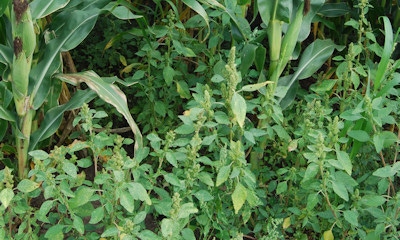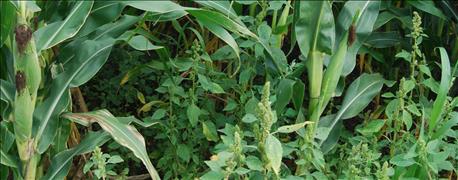
Even though it has been written about often, gaining more insight on weed resistance is a topic well worth further discussion.
To accomplish this, Penton Agriculture talked to experts from across the Midwest and asked them to share their thoughts on what tactics growers should be using to combat weed resistance.
Here’s what the experts had to say:
Mark Loux, professor of weed science, Ohio State University
Reviewing the effectiveness of your 2015 program is the first step in preparing for 2016, says Loux.
“Fall herbicide treatments are a key component to keep horseweed and other problem weeds under control,” he says.

WEEDS TO BEAT: Resistant weeds can gum up your crop works, cutting yields and costing you more in herbicide applications. Tackling them in a coordinated fashion can make a difference.
“Early in 2016 you should lay out four years of your herbicide program on a table and use tools to determine if there’s enough diversity in sites of action and what changes might be made to accomplish this.”
Loux’s top weed control tactics:
* Use different herbicide tolerance traits between corn and soybeans. Try to think about this over a four-year period.
* Use different sites of action between corn and soybeans.
* Pay close attention to weeds that always get sprayed postemergence, and make sure they’re not getting sprayed with the same herbicide site of action every year.
* Use multiple sites of action in the residual component of the program and multiple sites of action in the burndown component.
* Scout and walk fields in late summer, and remove weeds that could be resistant before they produce viable seed.
Bill Johnson, professor of weed science, Purdue University
Johnson believes many growers fall short in properly planning their early-season weed control efforts. This, in turn, has an impact on late-season weed control operations. Weeds are usually larger and harder to spray because the crop canopy has developed, and the weeds have already done economic damage to the fields.
“We certainly have a much higher awareness of herbicide resistance, but we still have a major problem with growers not worrying about resistance until they have it,” says Johnson.
Johnson’s top weed control tactics:
* Don’t continue to spray a single-mode-of-action herbicide to control all weeds in the field.
* Go after your worst weed control issues with at least two unique, effective modes of action.
* Plan for multiple passes through the field.
* Plan to rotate chemistries wherever possible.
* Plan to rotate the herbicide-resistant crops that you use.
Aaron Hager, associate professor and Extension specialist, University of Illinois
Hager advises growers to stop denying that herbicide resistance can occur in fields they farm. This is especially important when assessing the success of control efforts in 2015 and preparing for the 2016 season.
“Spend time throughout the growing season and winter months thinking about how you will manage weeds for not only the next growing season, but for three or four seasons after that,” says Hager.
Bottom line, Hager says any time you can reduce weed seeds going back into your soil, you’ll have fewer weeds to deal with in the future. The danger, though, is when growers reduce inputs — like weed control efforts — which can end up affecting revenue due to yield loss.
Hager’s top weed control tactics:
* Accept that weed spectrums change and that resistant weeds can be lurking on your farm.
* Diversify what you’re doing.
* Spend the time to understand this complex issue. Educate yourself and understand modes of action.
* Be diligent and don’t assume technology is going to solve the problem.
* Broaden your number of sources, seek help, and get input from others.
Bob Hartzler, professor and Extension weed specialist, Iowa State University
While evaluating the effectiveness of their 2015 efforts, Hartzler says growers need to look for the presence of “escapes” and determine why they are there. Is it herbicide resistance, poor selection of products, late-emerging weeds, unfavorable environmental conditions, or what?
“It can be difficult to determine exactly why weeds escaped control. Did they survive the postemergence application, or did they just emerge after the application? It’s important to know this, which is why scouting fields after herbicide applications is critical,” explains Hartzler.
Hartzler says growers realize that there’s a problem, but the costs associated with weed control measures, as well as slow-changing attitudes, hamper efforts to combat resistance.
Hartzler’s top weed control tactics:
* Apply full rates of effective preemergence products close to planting, not four to five weeks early.
* Scout fields within seven to 10 days of every herbicide application to determine how they’re working.
* For growers who have ruled out cultivation as a control tactic, use a narrow-row planter for 15- to 20-inch rows.
* Walk your fields and eliminate small patches of weeds, as isolated patches are often an indication of a new herbicide resistance problem.
* For fields where late-emerging waterhemp is a continuing problem, include a residual herbicide in an early postemergence treatment.
Jeff Gunsolus, professor of agronomy and weed science, University of Minnesota
Gunsolus believes identifying weeds and problem areas are important steps all growers should take from year to year. However, he feels growers fall short when it comes to paying close enough attention beyond their fields, where problem weeds can also lurk.
“Failure to conduct perimeter field management of weeds in ditches, fence rows and drainage areas is a mistake,” offers Gunsolus.
Gunsolus’ top weed control tactics:
* Identify your main target weeds.
* Use effective, multiple sites of action on target weeds.
* Rotate sites of action by year, and use multiyear planning.
* Start with a full label rate of a preemergence herbicide that’s effective on your target weeds.
* Control weeds when they’re small, and don’t let escapes produce seed.
- Yontz writes from Urbandale, Iowa.
Solution Center is independently produced by Penton Agriculture through support from SureStart ® II herbicide. For more information, visit GetMoreTime.com.
About the Author(s)
You May Also Like




